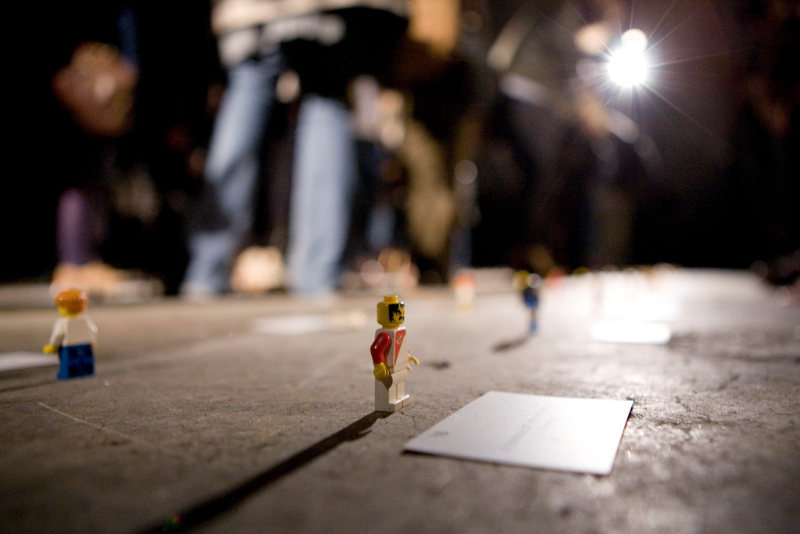Zilla Part 1 opens the doors to a huge empty warehouse in which an impressive amount of tiny Lego people are lined up in a miniature installation. We have been brought here, to Bristol’s Old Mills Industrial Estate and to the venue Unit 15, to contemplate the movie Godzilla. Casting my eye across the tiny Lego figures, I imagine them to be characters in a film. A small card lies next to each one with a description: ‘A woman preparing for an impossibly romantic picnic’, ‘An ordinary person who is unfortunately named David Cameron’, ‘An impersonator of a dead celebrity’. The titles are humorous and remarkably apt. We all spend time spread out amongst the figures, in rows, bending down to read and gaze at their painted facial expressions. Giggles and small conversations bubble around them. A sound track of old disaster movies hovers about relatively unnoticed.
We are asked to start to decide which of these figures we would like to be – who we want to be in the movie. We don’t know what will happen in the movie. This task is fun and people start to discuss their choices before finally picking up their figure and its card, toying with the limited limbs in their hands.
We take a seat for the next phase of the piece, and two performers enter and sit at a desk all the way over the other side of the warehouse, a good 10m away. The desk has two mics and two scripts upon it. Here begins a long monologue delivered by two people: when one is reading the other takes a marker pen and draws a map of a city on the floor, the performers alternating between these two tasks. The text is hard to stay with as it is delivered in a flat fashion, emotionless and far away; there’s humour, but it’s dry. A city is described; people are wandering around with nothing to do, so they pretend to wait at bus stops. The city is described as made, as formed; we are the ones who have constructed it in this way. A whole list of high street shops is reeled off. There is a general sense of the mundane and an unsettling idea that we are all existing with little to do and so waiting for something to happen, waiting for a disaster.
We are invited to come towards the city map, now complete on the floor, and place our Lego selves somewhere on the map. The map becomes populated and one performer wearing large furry gorilla-like slippers is blindfolded. A camera is set up on the floor by the map, which is then projected onto the wall of the warehouse. In the film we can see two huge furry monster feet and our tiny Lego figures standing vulnerable in front of them. In a hilariously crude fashion the performer stumbles through the map and through the Lego characters, crushing those in her path. I become incredibly worried for my Lego person; I gasp each time she steps over me, and there are sighs as each figure is crushed. It is funny, really funny, but with a simmering sense of tragedy as we act the destruction of a town and its people. We name all those who have been mangled by the trampling monster – ‘a failed magician’, ‘a man who has lost his memory of the last 5 years’. I am a survivor, so I pick up my Lego woman and take her home, relieved.
The piece moves somewhat confusedly between reality and fiction, between fact and film. 1930s Godzilla is described as existing within a New York in huge recession, reframing the movie as a portrait of a city that is destroying itself. I am made to reflect on the aftermath of a disaster, a real one, and then pulled back into the world of film as they performer’s tell us that the survivor’s make up is still perfectly done.
Zilla Part 1’s text and form plays with perception, with being small, big, up high or down low, altered visions of a city. My mind starts to view my own city with huge scaly feet swooping down into it. I leave ultimately a little disorientated with some fleeting feelings about disasters, holding onto what is now a mini-me, feeling protective but also concerned that we begin talking about disasters, straying into sensitive territory, but then are quickly scooped up by film and fiction and by the silly, the surreal and the artificial. But what are we really talking about here? An urge for destruction and disaster? This is a potentially explosive topic that could really go somewhere.
The story continued in Zilla Part 2 and Zilla Part 3, which also played at Bristol Mayfest.

